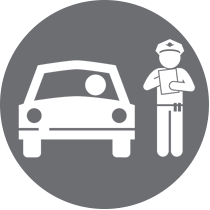The following events typically occur when someone is alleged to have committed a misdemeanor:
Arrest- When a person is accused of a misdemeanor they will be arrested and held by law enforcement. When this occurs, three things may happen:
- No charges are filed and the person is released;
- The person is charged and posts bail/bond and is released or the person is released on his or her own recognizance ("O.R." release) until arraignment in court; or
- The person is charged, but cannot post bail/bond and is not released on his or her own recognizance, and remains in custody until arraignment in court.
Arraignment- The arraignment is a defendant's first appearance in court if they are charged with a misdemeanor. At the arraignment, the judge informs the defendant of the charges filed against him or her; advises the defendant of his or her constitutional rights; and, if the defendant cannot afford a private attorney, that they have the right to a public defender.At arraignment, the defendant enters a plea of not guilty, guilty, or no contest. In general, these pleas have the following effect:
- Not Guilty: The defendant denies the charges filed against him or her and the case continues to the pretrial hearing. The defendant is either released on his or her own recognizance, or the court sets bail and the defendant is remanded to the custody of the Sheriff.
- Guilty: The defendant admits that that he or she committed the crime and is sentenced by the court. Sentences may include county jail time, probation, fines, community service, participation in rehabilitative programs, or some combination of these punishments.
- No Contest: The defendant does not contest (or challenge) the charge and the result is the same as a guilty plea, except that the conviction resulting from the plea cannot be used against the defendant as evidence of liability in a civil suit.
Pretrial Hearing- If the defendant pleads "not guilty" at arraignment, a pretrial hearing is set. At the pretrial hearing, the defense attorney and prosecutor exchange information such as police reports, witness statements and other evidence. The attorneys may also file pretrial motions challenging the charges or seeking to exclude certain evidence. At the pretrial hearing the defendant may also choose to change his or her plea from not guilty to guilty or no contest.
Trial (by Jury or by the Court) - If the defendant does not change his or her plea to "guilty" or "no contest," the case proceeds to a jury trial (or a trial without a jury if the defendant chooses). If the jury finds the defendant not guilty, the defendant is released and cannot be tried again for the same crime. If the jury finds the defendant guilty, the defendant will be sentenced either immediately or at a later hearing.
The following events typically occur when someone is alleged to have committed a felony:
Arrest- When a person is accused of a felony they will often be arrested and held by law enforcement. When this occurs, three things may happen:
- No charges are filed and the person is released;
- The person is charged and posts bail/bond and is released or the person is released on his or her own recognizance until arraignment in court;
- The person is charged, but cannot post bail/bond and is not released on his or her own recognizance, and remains in custody until arraignment in court; or
- The person is charged and is held without bail (this may occur in various serious felony cases or if the defendant is on probation, parole or is not a lawful U.S. citizen)
Arraignment- As with a misdemeanor, the arraignment is a defendant's first appearance in court. At the arraignment, the judge informs the defendant of the charges filed against him or her; advises the defendant of his or her constitutional rights; and, if the defendant cannot afford a private attorney, that they have the right to a public defender.At arraignment, the defendant enters a plea of not guilty, guilty, or no contest. In general, these pleas have the following effect:
- Not Guilty: The defendant denies the charges filed against him or her and the case continues to the pretrial hearing. The defendant is either released on his or her own recognizance," or the court sets bail and the defendant is remanded to the custody of the Sheriff.
- Guilty: The defendant admits that that he or she committed the crime and is sentenced by the court.
- No Contest: The defendant does not contest (or challenge) the charge and the result is the same as a guilty plea, except that the conviction resulting from the plea cannot be used against the defendant as evidence of liability in a civil suit.
Preliminary Hearing- Following arraignment, the defendant is entitled to a preliminary hearing. At the preliminary hearing, in order for the case against the defendant to move forward, the prosecutor must show that there is a sufficient suspicion that the defendant committed the crime alleged. This standard is much lower than the "beyond a reasonable doubt" standard to convict the defendant at trial. If the judge finds sufficient evidence at the preliminary hearing to meet this standard, the defendant is "held to answer" the felony charges and is "arraigned on the information" (see below) in the trial court.
Arraignment on the Information - The "Information" sets forth the charges against the defendant that passed the preliminary hearing and will be at issue at trial. At the arraignment on the information, the procedures at the initial arraignment occur again. The judge informs the defendant of the charges filed against him or her and the defendant again enters a plea of not guilty, guilty or no contest. If the defendant pleads "not guilty," the case is then set for trial.
Trial (by Jury or by the Court) - If the Defendant does not change his or her "not guilty" plea to a "no contest" or "guilty" plea the case proceeds to trial. At trial, the defendant has the right to be tried by a jury of his or her peers who will weigh the evidence presented and reach a verdict of "guilty" or "not guilty." (A defendant may waive this right and choose to have the judge, rather than a jury, hear the evidence and enter a verdict.) If the jury finds the defendant not guilty, the defendant is released and cannot be tried again for the same crime. If the jury finds the defendant guilty, the defendant will be sentenced either immediately or at a later hearing.








